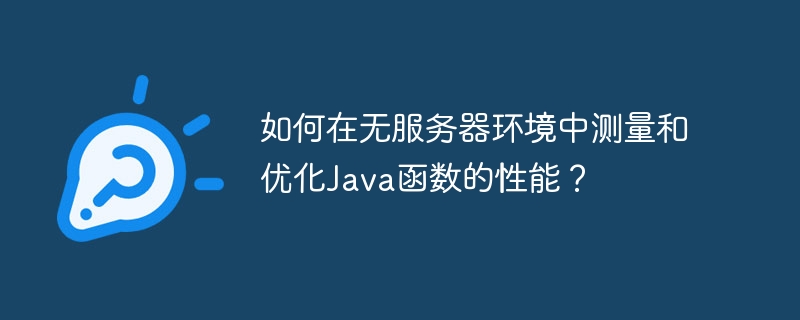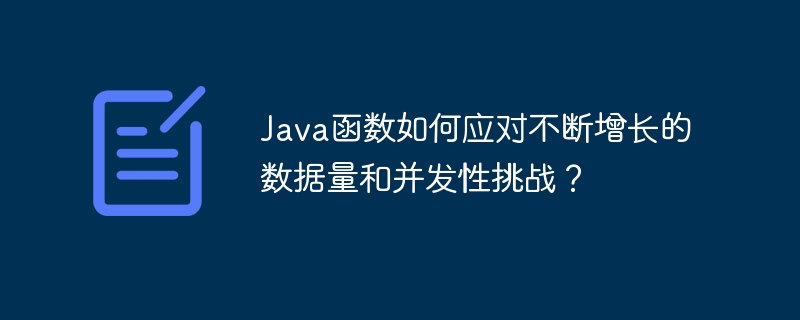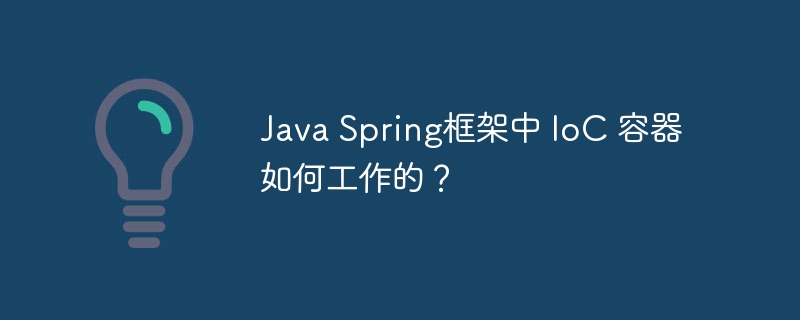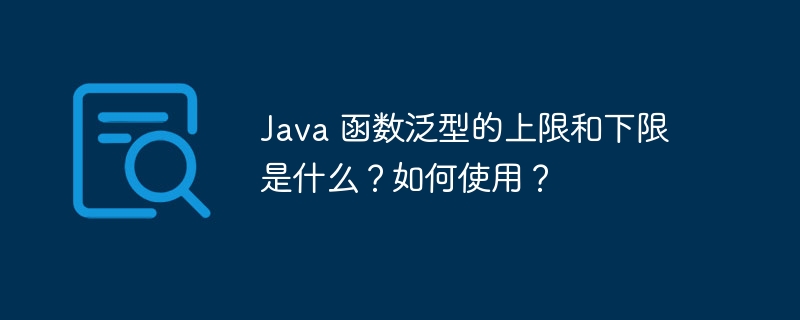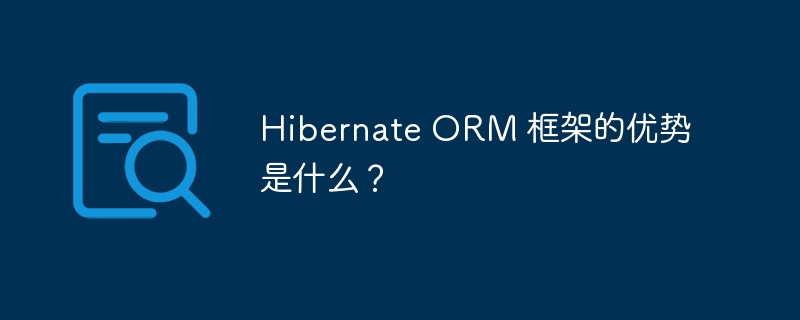springboot 整合 mqtt
最近由于iot越来越火, 物联网的需求越来越多, 那么理所当然的使用mqtt的场景也就越来越多,
接下来是我使用springboot整合mqtt的过程, 以及踩过的一些坑.
mqtt服务器使用的是 EMQX, 官网 : 这里
搭建的时候如果你使用的是集群 记得开放以下端口:
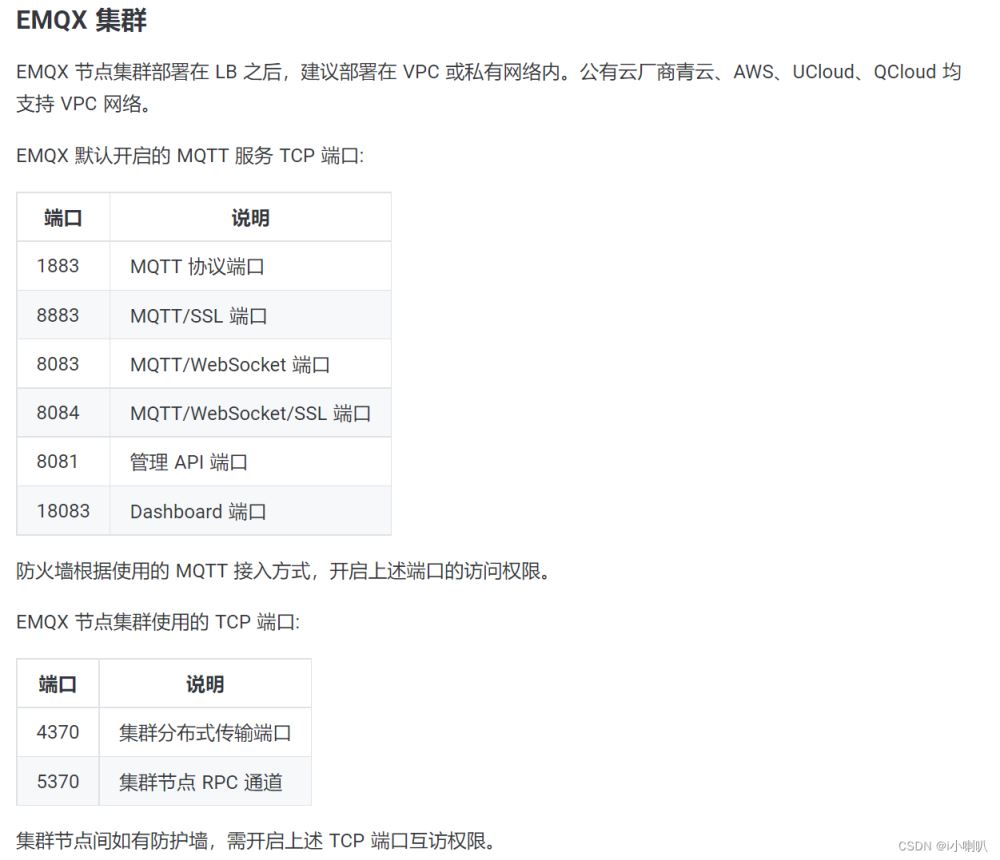
好了, 搭建成功下一步就是我们的java程序要与mqtt连接, 这里有两种方式(其实不止两种)进行连接.
一是 直接使用 MQTT Java 客户端库,详情可以查看官方的例子: MQTT Java 客户端 我就跳过了
二是使用 spring integration mqtt也是比较推荐的一种,也是我们主讲这种.
第一步 添加 maven dependency
<dependency>
<groupId>org.springframework.integration</groupId>
<artifactId>spring-integration-mqtt</artifactId>
<version>5.5.14</version>
</dependency>
第二步 添加配置
1 先写好一些基本配置
mqtt:
username: test # 账号
password: 123456 # 密码
host-url: tcp://127.0.0.1:1883 # mqtt连接tcp地址
in-client-id: ${random.value} # 随机值,使出入站 client ID 不同
out-client-id: ${random.value}
client-id: ${random.int} # 客户端Id,不能相同,采用随机数 ${random.value}
default-topic: test/#,topic/+/+/up # 默认主题
timeout: 60 # 超时时间
keepalive: 60 # 保持连接
clearSession: true # 清除会话(设置为false,断开连接,重连后使用原来的会话 保留订阅的主题,能接收离线期间的消息)
2.然后写一个对应的类MqttProperties
import org.springframework.beans.factory.annotation.Value;
import org.springframework.stereotype.Component;
/**
* MqttProperties
*
* @author hengzi
* @date 2022/8/23
*/
@Component
public class MqttProperties {
/**
* 用户名
*/
@Value("${mqtt.username}")
private String username;
/**
* 密码
*/
@Value("${mqtt.password}")
private String password;
/**
* 连接地址
*/
@Value("${mqtt.host-url}")
private String hostUrl;
/**
* 进-客户Id
*/
@Value("${mqtt.in-client-id}")
private String inClientId;
/**
* 出-客户Id
*/
@Value("${mqtt.out-client-id}")
private String outClientId;
/**
* 客户Id
*/
@Value("${mqtt.client-id}")
private String clientId;
/**
* 默认连接话题
*/
@Value("${mqtt.default-topic}")
private String defaultTopic;
/**
* 超时时间
*/
@Value("${mqtt.timeout}")
private int timeout;
/**
* 保持连接数
*/
@Value("${mqtt.keepalive}")
private int keepalive;
/**是否清除session*/
@Value("${mqtt.clearSession}")
private boolean clearSession;
// ...getter and setter
}
接下来就是配置一些乱七八糟的东西, 这里有很多概念性的东西 比如 管道channel, 适配器 adapter, 入站Inbound, 出站Outbound,等等等等, 看起来是非常头痛的
好吧,那就一个一个来,
首先连接mqtt需要一个客户端, 那么我们就开一个客户端工厂, 这里可以产生很多很多的客户端
@Bean
public MqttPahoClientFactory mqttPahoClientFactory(){
DefaultMqttPahoClientFactory factory = new DefaultMqttPahoClientFactory();
MqttConnectOptions options = new MqttConnectOptions();
options.setServerURIs(mqttProperties.getHostUrl().split(","));
options.setUserName(mqttProperties.getUsername());
options.setPassword(mqttProperties.getPassword().toCharArray());
factory.setConnectionOptions(options);
return factory;
}
然后再搞两根管子(channel),一个出站,一个入站
//出站消息管道,
@Bean
public MessageChannel mqttOutboundChannel(){
return new DirectChannel();
}
// 入站消息管道
@Bean
public MessageChannel mqttInboundChannel(){
return new DirectChannel();
}
为了使这些管子能流通 就需要一个适配器(adapter)
// Mqtt 管道适配器
@Bean
public MqttPahoMessageDrivenChannelAdapter adapter(MqttPahoClientFactory factory){
return new MqttPahoMessageDrivenChannelAdapter(mqttProperties.getInClientId(),factory,mqttProperties.getDefaultTopic().split(","));
}
然后定义消息生产者
// 消息生产者
@Bean
public MessageProducer mqttInbound(MqttPahoMessageDrivenChannelAdapter adapter){
adapter.setCompletionTimeout(5000);
adapter.setConverter(new DefaultPahoMessageConverter());
//入站投递的通道
adapter.setOutputChannel(mqttInboundChannel());
adapter.setQos(1);
return adapter;
}
那我们收到消息去哪里处理呢,答案是这里:
@Bean
//使用ServiceActivator 指定接收消息的管道为 mqttInboundChannel,投递到mqttInboundChannel管道中的消息会被该方法接收并执行
@ServiceActivator(inputChannel = "mqttInboundChannel")
public MessageHandler handleMessage() {
// 这个 mqttMessageHandle 其实就是一个 MessageHandler 的实现类(这个类我放下面)
return mqttMessageHandle;
// 你也可以这样写
// return new MessageHandler() {
// @Override
// public void handleMessage(Message<?> message) throws MessagingException {
// // do something
// }
// };
到这里我们其实已经可以接受到来自mqtt的消息了
接下来配置向mqtt发送消息
配置 出站处理器
// 出站处理器
@Bean
@ServiceActivator(inputChannel = "mqttOutboundChannel")
public MessageHandler mqttOutbound(MqttPahoClientFactory factory){
MqttPahoMessageHandler handler = new MqttPahoMessageHandler(mqttProperties.getOutClientId(),factory);
handler.setAsync(true);
handler.setConverter(new DefaultPahoMessageConverter());
handler.setDefaultTopic(mqttProperties.getDefaultTopic().split(",")[0]);
return handler;
}
这个 出站处理器 在我看来就是让别人 (MqttPahoMessageHandler)处理了, 我就不处理了,我只管我要发送什么,至于怎么发送,由MqttPahoMessageHandler来完成
接下来我们定义一个接口即可
import org.springframework.integration.annotation.MessagingGateway;
import org.springframework.integration.mqtt.support.MqttHeaders;
import org.springframework.messaging.handler.annotation.Header;
import org.springframework.stereotype.Component;
/**
* MqttGateway
*
* @author hengzi
* @date 2022/8/23
*/
@Component
@MessagingGateway(defaultRequestChannel = "mqttOutboundChannel")
public interface MqttGateway {
void sendToMqtt(@Header(MqttHeaders.TOPIC) String topic, String data);
void sendToMqtt(@Header(MqttHeaders.TOPIC) String topic, @Header(MqttHeaders.QOS) Integer Qos, String data);
}
我们直接调用这个接口就可以向mqtt 发送数据
到目前为止,整个配置文件长这样:
import org.eclipse.paho.client.mqttv3.MqttConnectOptions;
import org.springframework.beans.factory.annotation.Autowired;
import org.springframework.context.annotation.Bean;
import org.springframework.context.annotation.Configuration;
import org.springframework.integration.annotation.ServiceActivator;
import org.springframework.integration.channel.DirectChannel;
import org.springframework.integration.core.MessageProducer;
import org.springframework.integration.mqtt.core.DefaultMqttPahoClientFactory;
import org.springframework.integration.mqtt.core.MqttPahoClientFactory;
import org.springframework.integration.mqtt.inbound.MqttPahoMessageDrivenChannelAdapter;
import org.springframework.integration.mqtt.outbound.MqttPahoMessageHandler;
import org.springframework.integration.mqtt.support.DefaultPahoMessageConverter;
import org.springframework.messaging.Message;
import org.springframework.messaging.MessageChannel;
import org.springframework.messaging.MessageHandler;
import org.springframework.messaging.MessagingException;
/**
* MqttConfig
*
* @author hengzi
* @date 2022/8/23
*/
@Configuration
public class MqttConfig {
/**
* 以下属性将在配置文件中读取
**/
@Autowired
private MqttProperties mqttProperties;
//Mqtt 客户端工厂
@Bean
public MqttPahoClientFactory mqttPahoClientFactory(){
DefaultMqttPahoClientFactory factory = new DefaultMqttPahoClientFactory();
MqttConnectOptions options = new MqttConnectOptions();
options.setServerURIs(mqttProperties.getHostUrl().split(","));
options.setUserName(mqttProperties.getUsername());
options.setPassword(mqttProperties.getPassword().toCharArray());
factory.setConnectionOptions(options);
return factory;
}
// Mqtt 管道适配器
@Bean
public MqttPahoMessageDrivenChannelAdapter adapter(MqttPahoClientFactory factory){
return new MqttPahoMessageDrivenChannelAdapter(mqttProperties.getInClientId(),factory,mqttProperties.getDefaultTopic().split(","));
}
// 消息生产者
@Bean
public MessageProducer mqttInbound(MqttPahoMessageDrivenChannelAdapter adapter){
adapter.setCompletionTimeout(5000);
adapter.setConverter(new DefaultPahoMessageConverter());
//入站投递的通道
adapter.setOutputChannel(mqttInboundChannel());
adapter.setQos(1);
return adapter;
}
// 出站处理器
@Bean
@ServiceActivator(inputChannel = "mqttOutboundChannel")
public MessageHandler mqttOutbound(MqttPahoClientFactory factory){
MqttPahoMessageHandler handler = new MqttPahoMessageHandler(mqttProperties.getOutClientId(),factory);
handler.setAsync(true);
handler.setConverter(new DefaultPahoMessageConverter());
handler.setDefaultTopic(mqttProperties.getDefaultTopic().split(",")[0]);
return handler;
}
@Bean
//使用ServiceActivator 指定接收消息的管道为 mqttInboundChannel,投递到mqttInboundChannel管道中的消息会被该方法接收并执行
@ServiceActivator(inputChannel = "mqttInboundChannel")
public MessageHandler handleMessage() {
return mqttMessageHandle;
}
//出站消息管道,
@Bean
public MessageChannel mqttOutboundChannel(){
return new DirectChannel();
}
// 入站消息管道
@Bean
public MessageChannel mqttInboundChannel(){
return new DirectChannel();
}
}
处理消息的 MqttMessageHandle
@Component
public class MqttMessageHandle implements MessageHandler {
@Override
public void handleMessage(Message<?> message) throws MessagingException {
}
}
在进一步了解之后,发现可以优化的地方,比如channel 的类型是有很多种的, 这里使用的DirectChannel,是Spring Integration默认的消息通道,它将消息发送给为一个订阅者,然后阻碍发送直到消息被接收,传输方式都是同步的方式,都是由一个线程来运行的.
这里我们可以将入站channel改成 ExecutorChannel一个可以使用多线程的channel
@Bean
public ThreadPoolTaskExecutor mqttThreadPoolTaskExecutor()
{
ThreadPoolTaskExecutor executor = new ThreadPoolTaskExecutor();
// 最大可创建的线程数
int maxPoolSize = 200;
executor.setMaxPoolSize(maxPoolSize);
// 核心线程池大小
int corePoolSize = 50;
executor.setCorePoolSize(corePoolSize);
// 队列最大长度
int queueCapacity = 1000;
executor.setQueueCapacity(queueCapacity);
// 线程池维护线程所允许的空闲时间
int keepAliveSeconds = 300;
executor.setKeepAliveSeconds(keepAliveSeconds);
// 线程池对拒绝任务(无线程可用)的处理策略
executor.setRejectedExecutionHandler(new ThreadPoolExecutor.CallerRunsPolicy());
return executor;
}
// 入站消息管道
@Bean
public MessageChannel mqttInboundChannel(){
// 用线程池
return new ExecutorChannel(mqttThreadPoolTaskExecutor());
}
到这里其实可以运行了.
但是这样配置其实还是有点多, 有点乱, 于是我查找官网, f发现一种更简单的配置方法 叫 Java DSL, 官网连接: Configuring with the Java DSL
我们参考官网,稍微改一下,使用 DSL的方式进行配置:
import org.eclipse.paho.client.mqttv3.MqttConnectOptions;
import org.springframework.beans.factory.annotation.Autowired;
import org.springframework.context.annotation.Bean;
import org.springframework.context.annotation.Configuration;
import org.springframework.integration.channel.ExecutorChannel;
import org.springframework.integration.dsl.IntegrationFlow;
import org.springframework.integration.dsl.IntegrationFlows;
import org.springframework.integration.mqtt.core.DefaultMqttPahoClientFactory;
import org.springframework.integration.mqtt.core.MqttPahoClientFactory;
import org.springframework.integration.mqtt.inbound.MqttPahoMessageDrivenChannelAdapter;
import org.springframework.integration.mqtt.outbound.MqttPahoMessageHandler;
import org.springframework.integration.mqtt.support.DefaultPahoMessageConverter;
import org.springframework.scheduling.concurrent.ThreadPoolTaskExecutor;
import java.util.concurrent.ThreadPoolExecutor;
/**
* MqttConfigV2
*
* @author hengzi
* @date 2022/8/24
*/
@Configuration
public class MqttConfigV2 {
@Autowired
private MqttProperties mqttProperties;
@Autowired
private MqttMessageHandle mqttMessageHandle;
//Mqtt 客户端工厂 所有客户端从这里产生
@Bean
public MqttPahoClientFactory mqttPahoClientFactory(){
DefaultMqttPahoClientFactory factory = new DefaultMqttPahoClientFactory();
MqttConnectOptions options = new MqttConnectOptions();
options.setServerURIs(mqttProperties.getHostUrl().split(","));
options.setUserName(mqttProperties.getUsername());
options.setPassword(mqttProperties.getPassword().toCharArray());
factory.setConnectionOptions(options);
return factory;
}
// Mqtt 管道适配器
@Bean
public MqttPahoMessageDrivenChannelAdapter adapter(MqttPahoClientFactory factory){
return new MqttPahoMessageDrivenChannelAdapter(mqttProperties.getInClientId(),factory,mqttProperties.getDefaultTopic().split(","));
}
// 消息生产者 (接收,处理来自mqtt的消息)
@Bean
public IntegrationFlow mqttInbound(MqttPahoMessageDrivenChannelAdapter adapter) {
adapter.setCompletionTimeout(5000);
adapter.setQos(1);
return IntegrationFlows.from( adapter)
.channel(new ExecutorChannel(mqttThreadPoolTaskExecutor()))
.handle(mqttMessageHandle)
.get();
}
@Bean
public ThreadPoolTaskExecutor mqttThreadPoolTaskExecutor()
{
ThreadPoolTaskExecutor executor = new ThreadPoolTaskExecutor();
// 最大可创建的线程数
int maxPoolSize = 200;
executor.setMaxPoolSize(maxPoolSize);
// 核心线程池大小
int corePoolSize = 50;
executor.setCorePoolSize(corePoolSize);
// 队列最大长度
int queueCapacity = 1000;
executor.setQueueCapacity(queueCapacity);
// 线程池维护线程所允许的空闲时间
int keepAliveSeconds = 300;
executor.setKeepAliveSeconds(keepAliveSeconds);
// 线程池对拒绝任务(无线程可用)的处理策略
executor.setRejectedExecutionHandler(new ThreadPoolExecutor.CallerRunsPolicy());
return executor;
}
// 出站处理器 (向 mqtt 发送消息)
@Bean
public IntegrationFlow mqttOutboundFlow(MqttPahoClientFactory factory) {
MqttPahoMessageHandler handler = new MqttPahoMessageHandler(mqttProperties.getOutClientId(),factory);
handler.setAsync(true);
handler.setConverter(new DefaultPahoMessageConverter());
handler.setDefaultTopic(mqttProperties.getDefaultTopic().split(",")[0]);
return IntegrationFlows.from( "mqttOutboundChannel").handle(handler).get();
}
}
这样看起来真的简单多了, 头也没那么大了, 我要是早知道多好.
但其实我一直有个想法, 就是我们接收的消息 都是在 handleMessage这个方法里面执行的,
@Override
public void handleMessage(Message<?> message) throws MessagingException {
}
所以我就有了一个想法, 能不能根据 我订阅的主题,在不同的方法执行, 对于这个问题,其实你用if ... else ...也能实现, 但很明显,如果我订阅的主题很多的话, 那写起来就很头痛了.
对于这个问题,有两种思路, 一个是添加Spring Integration的路由 router,根据不同topic路由到不同的channel, 这个我也知道能不能实现, 我这里就不讨论了.
第二种是, 我也不知道名字改如何叫, 我是参考了 spring的 @Controller的设计, 暂且叫他注解模式.
众所周知,我们的接口都是在类上加 @Controller这个注解, 就代表这个类是 http 接口, 再在方法加上 @RequestMapping就能实现不同的 url 调用不同的方法.
参数这个设计 我们在类上面加 @MqttService就代表这个类是专门处理mqtt消息的服务类
同时 在这个类的方法上 加上 @MqttTopic就代表 这个主题由这个方法处理.
OK, 理论有了,接下来就是 实践.
先定义 两个注解
import org.springframework.core.annotation.AliasFor;
import org.springframework.stereotype.Component;
import java.lang.annotation.*;
@Documented
@Target({ElementType.TYPE})
@Retention(RetentionPolicy.RUNTIME)
@Component
public @interface MqttService {
@AliasFor(
annotation = Component.class
)
String value() default "";
}
加上 @Component注解 spring就会扫描, 并注册到IOC容器里
import java.lang.annotation.ElementType;
import java.lang.annotation.Retention;
import java.lang.annotation.RetentionPolicy;
import java.lang.annotation.Target;
@Target(ElementType.METHOD)
@Retention(RetentionPolicy.RUNTIME)
public @interface MqttTopic {
/**
* 主题名字
*/
String value() default "";
}
参考 @RequestMapping我们使用起来应该是这样的:
import org.slf4j.Logger;
import org.slf4j.LoggerFactory;
import org.springframework.messaging.Message;
/**
* MqttTopicHandle
*
* @author hengzi
* @date 2022/8/24
*/
@MqttService
public class MqttTopicHandle {
public static final Logger log = LoggerFactory.getLogger(MqttTopicHandle.class);
// 这里的 # 号是通配符
@MqttTopic("test/#")
public void test(Message<?> message){
log.info("test="+message.getPayload());
}
// 这里的 + 号是通配符
@MqttTopic("topic/+/+/up")
public void up(Message<?> message){
log.info("up="+message.getPayload());
}
// 注意 你必须先订阅
@MqttTopic("topic/1/2/down")
public void down(Message<?> message){
log.info("down="+message.getPayload());
}
}
OK 接下来就是实现这样的使用
分析 :
当我们收到消息时, 我们从IOC容器中 找到所有 带 @MqttService注解的类
然后 遍历这些类, 找到带有 @MqttTopic的方法
接着 把 @MqttTopic注解的的值 与 接受到的topic 进行对比
如果一致则执行这个方法
废话少说, 上代码
import org.slf4j.Logger;
import org.slf4j.LoggerFactory;
import org.springframework.messaging.Message;
import org.springframework.messaging.MessageHandler;
import org.springframework.messaging.MessagingException;
import org.springframework.stereotype.Component;
import java.lang.reflect.InvocationTargetException;
import java.lang.reflect.Method;
import java.util.Map;
/**
* MessageHandleService
*
* @author hengzi
* @date 2022/8/24
*/
@Component
public class MqttMessageHandle implements MessageHandler {
public static final Logger log = LoggerFactory.getLogger(MqttMessageHandle.class);
// 包含 @MqttService注解 的类(Component)
public static Map<String, Object> mqttServices;
/**
* 所有mqtt到达的消息都会在这里处理
* 要注意这个方法是在线程池里面运行的
* @param message message
*/
@Override
public void handleMessage(Message<?> message) throws MessagingException {
getMqttTopicService(message);
}
public Map<String, Object> getMqttServices(){
if(mqttServices==null){
mqttServices = SpringUtils.getBeansByAnnotation(MqttService.class);
}
return mqttServices;
}
public void getMqttTopicService(Message<?> message){
// 在这里 我们根据不同的 主题 分发不同的消息
String receivedTopic = message.getHeaders().get("mqtt_receivedTopic",String.class);
if(receivedTopic==null || "".equals(receivedTopic)){
return;
}
for(Map.Entry<String, Object> entry : getMqttServices().entrySet()){
// 把所有带有 @MqttService 的类遍历
Class<?> clazz = entry.getValue().getClass();
// 获取他所有方法
Method[] methods = clazz.getDeclaredMethods();
for ( Method method: methods ){
if (method.isAnnotationPresent(MqttTopic.class)){
// 如果这个方法有 这个注解
MqttTopic handleTopic = method.getAnnotation(MqttTopic.class);
if(isMatch(receivedTopic,handleTopic.value())){
// 并且 这个 topic 匹配成功
try {
method.invoke(SpringUtils.getBean(clazz),message);
return;
} catch (IllegalAccessException e) {
e.printStackTrace();
log.error("代理炸了");
} catch (InvocationTargetException e) {
log.error("执行 {} 方法出现错误",handleTopic.value(),e);
}
}
}
}
}
}
/**
* mqtt 订阅的主题与我实际的主题是否匹配
* @param topic 是实际的主题
* @param pattern 是我订阅的主题 可以是通配符模式
* @return 是否匹配
*/
public static boolean isMatch(String topic, String pattern){
if((topic==null) || (pattern==null) ){
return false;
}
if(topic.equals(pattern)){
// 完全相等是肯定匹配的
return true;
}
if("#".equals(pattern)){
// # 号代表所有主题 肯定匹配的
return true;
}
String[] splitTopic = topic.split("/");
String[] splitPattern = pattern.split("/");
boolean match = true;
// 如果包含 # 则只需要判断 # 前面的
for (int i = 0; i < splitPattern.length; i++) {
if(!"#".equals(splitPattern[i])){
// 不是# 号 正常判断
if(i>=splitTopic.length){
// 此时长度不相等 不匹配
match = false;
break;
}
if(!splitTopic[i].equals(splitPattern[i]) && !"+".equals(splitPattern[i])){
// 不相等 且不等于 +
match = false;
break;
}
}
else {
// 是# 号 肯定匹配的
break;
}
}
return match;
}
}
工具类 SpringUtils
import org.springframework.aop.framework.AopContext;
import org.springframework.beans.BeansException;
import org.springframework.beans.factory.NoSuchBeanDefinitionException;
import org.springframework.beans.factory.config.BeanFactoryPostProcessor;
import org.springframework.beans.factory.config.ConfigurableListableBeanFactory;
import org.springframework.context.ApplicationContext;
import org.springframework.context.ApplicationContextAware;
import org.springframework.stereotype.Component;
import java.util.Map;
/**
* spring工具类 方便在非spring管理环境中获取bean
*
*/
@Component
public final class SpringUtils implements BeanFactoryPostProcessor, ApplicationContextAware
{
/** Spring应用上下文环境 */
private static ConfigurableListableBeanFactory beanFactory;
private static ApplicationContext applicationContext;
public static Map<String, Object> getBeansByAnnotation(Class clsName) throws BeansException{
return beanFactory.getBeansWithAnnotation(clsName);
}
@Override
public void postProcessBeanFactory(ConfigurableListableBeanFactory beanFactory) throws BeansException
{
SpringUtils.beanFactory = beanFactory;
}
@Override
public void setApplicationContext(ApplicationContext applicationContext) throws BeansException
{
SpringUtils.applicationContext = applicationContext;
}
/**
* 获取对象
*
* @param name
* @return Object 一个以所给名字注册的bean的实例
* @throws org.springframework.beans.BeansException
*
*/
@SuppressWarnings("unchecked")
public static <T> T getBean(String name) throws BeansException
{
return (T) beanFactory.getBean(name);
}
/**
* 获取类型为requiredType的对象
*
* @param clz
* @return
* @throws org.springframework.beans.BeansException
*
*/
public static <T> T getBean(Class<T> clz) throws BeansException
{
T result = (T) beanFactory.getBean(clz);
return result;
}
/**
* 如果BeanFactory包含一个与所给名称匹配的bean定义,则返回true
*
* @param name
* @return boolean
*/
public static boolean containsBean(String name)
{
return beanFactory.containsBean(name);
}
/**
* 判断以给定名字注册的bean定义是一个singleton还是一个prototype。 如果与给定名字相应的bean定义没有被找到,将会抛出一个异常(NoSuchBeanDefinitionException)
*
* @param name
* @return boolean
* @throws org.springframework.beans.factory.NoSuchBeanDefinitionException
*
*/
public static boolean isSingleton(String name) throws NoSuchBeanDefinitionException
{
return beanFactory.isSingleton(name);
}
/**
* @param name
* @return Class 注册对象的类型
* @throws org.springframework.beans.factory.NoSuchBeanDefinitionException
*
*/
public static Class<?> getType(String name) throws NoSuchBeanDefinitionException
{
return beanFactory.getType(name);
}
/**
* 如果给定的bean名字在bean定义中有别名,则返回这些别名
*
* @param name
* @return
* @throws org.springframework.beans.factory.NoSuchBeanDefinitionException
*
*/
public static String[] getAliases(String name) throws NoSuchBeanDefinitionException
{
return beanFactory.getAliases(name);
}
/**
* 获取aop代理对象
*
* @param invoker
* @return
*/
@SuppressWarnings("unchecked")
public static <T> T getAopProxy(T invoker)
{
return (T) AopContext.currentProxy();
}
/**
* 获取当前的环境配置,无配置返回null
*
* @return 当前的环境配置
*/
public static String[] getActiveProfiles()
{
return applicationContext.getEnvironment().getActiveProfiles();
}
}
OK, 大功告成. 终于舒服了, 终于不用写if...else...了, 个人感觉这样处理起来会更加优雅. 写代码最重要是什么, 是优雅~
以上!
参考文章:
附:
动态添加主题方式:
import org.springframework.beans.factory.annotation.Autowired;
import org.springframework.integration.mqtt.inbound.MqttPahoMessageDrivenChannelAdapter;
import org.springframework.stereotype.Service;
import java.util.Arrays;
/**
* MqttService
*
* @author hengzi
* @date 2022/8/25
*/
@Service
public class MqttService {
@Autowired
private MqttPahoMessageDrivenChannelAdapter adapter;
public void addTopic(String topic) {
addTopic(topic, 1);
}
public void addTopic(String topic,int qos) {
String[] topics = adapter.getTopic();
if(!Arrays.asList(topics).contains(topic)){
adapter.addTopic(topic,qos);
}
}
public void removeTopic(String topic) {
adapter.removeTopic(topic);
}
}
直接调用就行
总结
